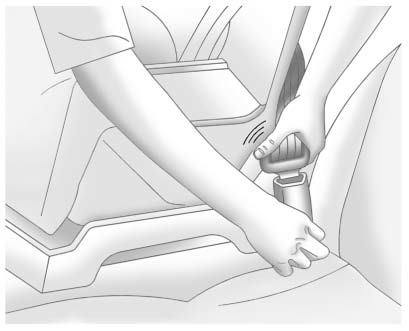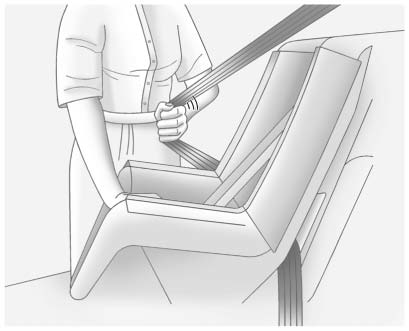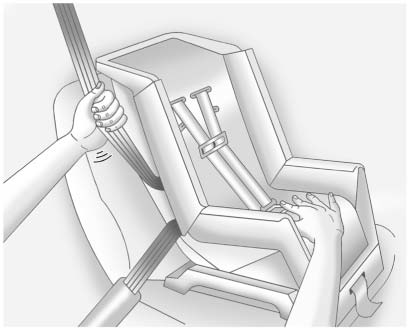 Buick Enclave: Securing Child Restraints (Rear Seat)
Buick Enclave: Securing Child Restraints (Rear Seat)
When securing a child restraint in a rear seating position, study the instructions that came with the child restraint to make sure it is compatible with this vehicle.
If the child restraint has the LATCH system, see Lower Anchors and Tethers for Children (LATCH System) for how and where to install the child restraint using LATCH. If a child restraint is secured in the vehicle using a safety belt and it uses a top tether, see Lower Anchors and Tethers for Children (LATCH System) for top tether anchor locations.
Do not secure a child seat in a position without a top tether anchor if a national or local law requires that the top tether be anchored, or if the instructions that come with the child restraint say that the top strap must be anchored.
In Canada, the law requires that forward-facing child restraints have a top tether, and that the tether be attached.
If the child restraint does not have the LATCH system, you will be using the safety belt to secure the child restraint in this position.
Be sure to follow the instructions that came with the child restraint.
Secure the child in the child restraint when and as the instructions say.
If more than one child restraint needs to be installed in the rear seat, be sure to read Where to Put the Restraint .
1. Put the child restraint on the seat.
2. Pick up the latch plate, and run the lap and shoulder portions of the vehicle's
safety belt through or around the restraint. The child restraint instructions will
show you how.

3. Push the latch plate into the buckle until it clicks.
Position the release button on the buckle so that the safety belt could be quickly unbuckled if necessary.

4. Pull the shoulder belt all the way out of the retractor to set the lock. When the retractor lock is set, the shoulder belt can be tightened but not pulled out of the retractor.

5. To tighten the belt, push down on the child restraint, pull the shoulder portion of the belt to tighten the lap portion of the belt, and feed the shoulder belt back into the retractor. When installing a forward-facing child restraint, it may be helpful to use your knee to push down on the child restraint as you tighten the belt.
Try to pull the belt out of the retractor to make sure the retractor is locked. If the retractor is not locked, repeat Steps 4 and 5.
6. If the child restraint has a top tether, follow the child restraint manufacturer's
instructions regarding the use of the top tether. See Lower Anchors and Tethers
for Children (LATCH System) for more information.
7. Before placing a child in the child restraint, make sure it is securely held
in place. To check, grasp the child restraint at the safety belt path and attempt
to move it side to side and back and forth. When the child restraint is properly
installed, there should be no more than 2.5 cm (1 in) of movement.
To remove the child restraint, unbuckle the vehicle safety belt and let it return to the stowed position.
If the top tether is attached to a top tether anchor, disconnect it.
 Replacing LATCH System Parts After a Crash
Replacing LATCH System Parts After a Crash
WARNING
A crash can damage the LATCH system in the vehicle.
► damaged LATCH system may not properly secure the child restraint, resulting in
serious injury or even death in a crash.
To help ...
 Securing Child Restraints (Right Front Passenger Seat)
Securing Child Restraints (Right Front Passenger Seat)
The vehicle has airbags. A rear seat is a safer place to secure a forward-facing
child restraint.
See Where to Put the Restraint .
In addition, the vehicle has a passenger sensing system which is ...
See also:
Pairing and connecting using the mobile phone
Note: The process of pairing and connecting your phone with the vehicle using
the mobile phone will vary depending on the type of mobile phone used.
1. Switch the ignition system on and ensure that ...
Roadside Service
U.S.: 1-800-224-1400
Canada: 1-800-882-1112
TTY Users (U.S. only): 1-888-889-2438
Mexico: 01-800-466-0805
As the owner of a new Cadillac, you are automatically enrolled in the Roadside
Service pr ...
Returning the Seatback to the Upright Position
To return the seatback to the upright position:
1. Open the liftgate to access the controls for the seat.
2. Raise the seatback to the upright position.
WARNING
If either seatback is not locke ...






